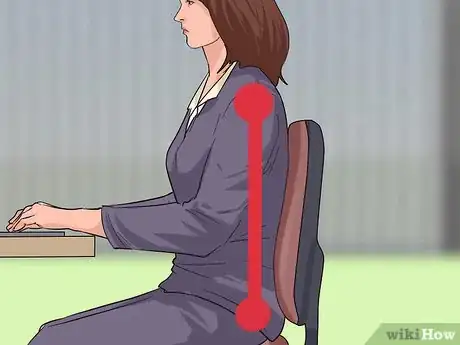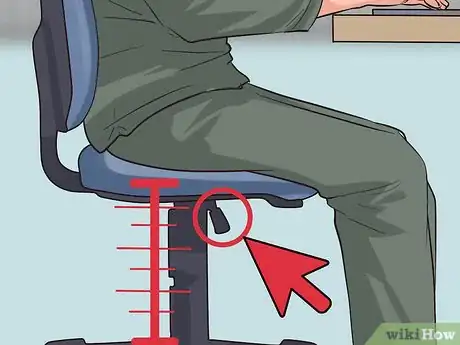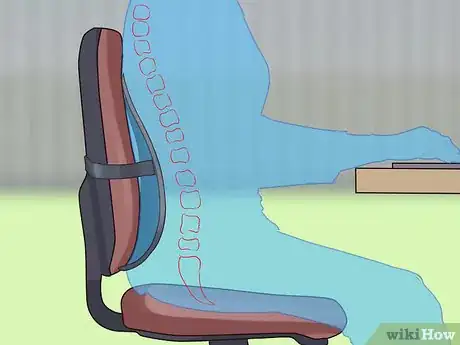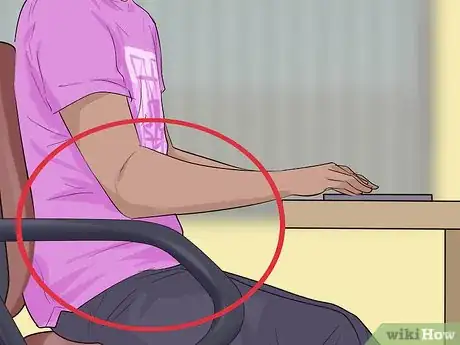This article was medically reviewed by Laura Flinn. Laura Flinn is a National Academy of Sports Medicine (NASM) Certified Personal Trainer, USA Olympic Weightlifting Sports Performance Coach and Certified Fitness Nutritionist, with an additional qualification as a TRX Suspension Trainer. Laura runs her own personal training program based in the San Francisco Bay Area and specializes in topics such as weight loss, muscle growth, cardiovascular training, and strength training.
This article has been viewed 637,071 times.
Recent studies by the World Health Organization and the Archives of Internal Medicine suggest that workers who sit for long periods of time, as many as 6 hours a day, are 40 percent more likely of dying at any given point, of a variety of afflictions and diseases, than people who sit less. While you can't avoid sitting in the office environment, learning how to sit properly wherever you're sitting can help keep you healthy and safe.
Steps
Using Proper Posture
-
1Push your hips as far back as they can go in the chair. In office chairs, the best way to sit is to let the shaped back support your back and shoulders by scooting your hips back as far as they go, then adjusting the other components of the chair to offer support.[1]
- If you're sitting in a straight, hard-backed chair, scoot your bottom up to the edge of the chair and sit without slouching into the back of that chair. Sit with your back and shoulders as straight as if they were supported by the chair back. Over time, this is a more comfortable position for your back, neck, and shoulders.
- If you're sitting in a lounge chair or a couch, it's important to keep your feet flat on the floor and your back straight. Your shoulders should be back and you should be as far forward on the couch as possible.
-
2Keep your shoulders back and your back straight.[2] Wherever and however you're sitting, it's important to keep your shoulders back to avoid slouching or hunching your back as you sit. Over time, this can strain your neck and shoulders, leading to chronic pain and headaches.
- Don't lean your chair backward or slouch yourself forward while you're sitting, or you can strain your sciatic nerve and your shoulder muscles. This serves to keep you off-balance.
- It is good to rock gently, if possible, if you're going to be sitting for a longer time. This helps to keep the body active and balanced.
Advertisement -
3Adjust the seat height to fit your body. The seat of your chair should be high enough so that your feet are flat on the floor and your knees are even with your hips, or slightly lower.[3] If you sit too low in the chair, you can end up straining your neck, while if you sit too high, your shoulders can get tired over time.[4]
- If you need to adjust your seat so that it is higher, you may find that your feet don't comfortably reach the ground. Try putting a stool, cushion, or another object under your feet.
-
4Adjust the back of the chair to a 100°-110° reclined angle. Ideally, the back of a passive reclining chair shouldn't be perfectly straight, but angled backward gently beyond the 90 degree mark. This is much more comfortable and supportive for your back than a perfectly straight back.[5]
-
5Make sure that your upper and lower back are supported. Good passive office chairs should offer some back support, protruding slightly in the lower back to support your spine on both sides, keeping you comfortable and upright.[6] If you don't have this kind of support, however, you have to make do yourself.
- If necessary, use inflatable cushions or small pillows, just above your hips, between the back of the chair and your spine. This should be a lot more comfortable.
- When your chair has an active back mechanism use it to make frequent position changes, gently adjusting it and rocking backward and forward as you sit and work, keeping your back from staying sedentary.
-
6Adjust the armrests. Ideally, your armrests should be adjusted so that your shoulders are relaxed and your wrists are even with your keyboard, if you're typing. Read the next section for more specific suggestions about sitting at the computer.
- Alternatively, you can remove the armrests completely if you find that they are in your way. Armrests aren't necessary for support.
Sitting Properly at the Office or Computer
-
1Sit in an active sitting chair if one is available. Increasingly, research reveals that sitting for long periods of time in an office setting comes with severe health concerns, including back and shoulder strain, as well as increased risk of heart disease.[7] For this reason, active sitting methods are more popular than ever, and might be a good option for you.
- Active sitting devices include things like standing desks, treadmill desks, kneeling chairs, and other ergonomic alternatives that force your body to hold itself upright, rather than providing it a resting place.
- Passive sitting chairs, even ergonomic ones, can have a tendency to force your spine into uncomfortable upright positions.
-
2Position your keyboard correctly. Adjust the keyboard height so that your shoulders are relaxed, your elbows are in a slightly open position, just out from your body, and your wrists and hands are straight.
- Use the keyboard tray mechanism, or keyboard feet, to adjust the tilt so that the keyboard is comfortable. If you sit in a forward or upright position, try tilting your keyboard away from you, but if you are slightly reclined, then a slight forward tilt will help to maintain a straight wrist position.
- Ergonomic keyboards are bent in the middle, to allow a more natural wrist alignment, letting your type with your thumbs pointing toward the ceiling, rather than lining your palms up with the floor. Consider investing in one if you struggle with wrist pain.
-
3Adjust the monitor and source documents properly. Ideally, you want your neck in a neutral, relaxed position, so you don't have to crane around to see what you're working on. Center the monitor directly in front of you, above your keyboard.
- Position the top of the monitor approximately 2-3” below your seated eye level.
- If you wear bifocals, lower the monitor to a comfortable reading level.[8]
-
4Consider using an ergonomic mouse. An ergonomic mouse allows your wrist to remain parallel to your body, it's natural resting state, rather than parallel with the floor, which can lead to carpal tunnel over many repetitions.
- The trackpad on most laptops and the traditional mouse do the same thing traditional keyboards do: force your wrists into an unnatural position. Over time, this can cause carpal tunnel issues and chronic pain.
-
5Take periodic breaks. Every 30-60 minutes, you need to take a short break from sitting and move around the office. Even just taking a short break to walk to the bathroom, or get a refill of water can help to break up the monotony and relieve pain. While you might feel silly, close your office door and try the following short exercises to get the blood flowing:
- Do 5-10 shoulder raises or shrugs
- Do 20 calf raises
- Do 5-10 lunges
- Touch your toes 20 times
-
6Stay as active as possible at work. If you work at an office, it's essential to get up and move around periodically to avoid stress pains and long-term damage to your arms, neck, shoulders, and back. Check out these articles for other tips and tricks about staying active at work:
Expert Q&A
Did you know you can get expert answers for this article?
Unlock expert answers by supporting wikiHow
-
QuestionHow should I sit at a computer?
 Laura FlinnLaura Flinn is a National Academy of Sports Medicine (NASM) Certified Personal Trainer, USA Olympic Weightlifting Sports Performance Coach and Certified Fitness Nutritionist, with an additional qualification as a TRX Suspension Trainer. Laura runs her own personal training program based in the San Francisco Bay Area and specializes in topics such as weight loss, muscle growth, cardiovascular training, and strength training.
Laura FlinnLaura Flinn is a National Academy of Sports Medicine (NASM) Certified Personal Trainer, USA Olympic Weightlifting Sports Performance Coach and Certified Fitness Nutritionist, with an additional qualification as a TRX Suspension Trainer. Laura runs her own personal training program based in the San Francisco Bay Area and specializes in topics such as weight loss, muscle growth, cardiovascular training, and strength training.
NASM Certified Personal Trainer
-
QuestionWhat is the best way to sit in a computer chair?
 Laura FlinnLaura Flinn is a National Academy of Sports Medicine (NASM) Certified Personal Trainer, USA Olympic Weightlifting Sports Performance Coach and Certified Fitness Nutritionist, with an additional qualification as a TRX Suspension Trainer. Laura runs her own personal training program based in the San Francisco Bay Area and specializes in topics such as weight loss, muscle growth, cardiovascular training, and strength training.
Laura FlinnLaura Flinn is a National Academy of Sports Medicine (NASM) Certified Personal Trainer, USA Olympic Weightlifting Sports Performance Coach and Certified Fitness Nutritionist, with an additional qualification as a TRX Suspension Trainer. Laura runs her own personal training program based in the San Francisco Bay Area and specializes in topics such as weight loss, muscle growth, cardiovascular training, and strength training.
NASM Certified Personal Trainer
-
QuestionHow can I sit comfortably if I have chronic back pain?
 Sarah Gehrke, RN, MSSarah Gehrke is a Registered Nurse and Licensed Massage Therapist in Texas. Sarah has over 10 years of experience teaching and practicing phlebotomy and intravenous (IV) therapy using physical, psychological, and emotional support. She received her Massage Therapist License from the Amarillo Massage Therapy Institute in 2008 and a M.S. in Nursing from the University of Phoenix in 2013.
Sarah Gehrke, RN, MSSarah Gehrke is a Registered Nurse and Licensed Massage Therapist in Texas. Sarah has over 10 years of experience teaching and practicing phlebotomy and intravenous (IV) therapy using physical, psychological, and emotional support. She received her Massage Therapist License from the Amarillo Massage Therapy Institute in 2008 and a M.S. in Nursing from the University of Phoenix in 2013.
Registered Nurse Sitting can definitely aggravate that existing back pain. For work, it sounds like a standing desk that can also decrease in height for short periods of sitting is a good option. At home (and in the office) you can try alternating from standing, sitting, stooping, squaring, and kneeling. You may also need to try a foot rest! Also, if you haven't seen a doctor about the chronic pain, that is a good place to start. They can provide you with a physical therapist that can give you some good pointers and stretches to help.
Sitting can definitely aggravate that existing back pain. For work, it sounds like a standing desk that can also decrease in height for short periods of sitting is a good option. At home (and in the office) you can try alternating from standing, sitting, stooping, squaring, and kneeling. You may also need to try a foot rest! Also, if you haven't seen a doctor about the chronic pain, that is a good place to start. They can provide you with a physical therapist that can give you some good pointers and stretches to help.
References
- ↑ http://www.ergonomics.com.au/pages/400_useful_info/420_how_to_sit.htm
- ↑ Laura Flinn. NASM Certified Personal Trainer. Expert Interview. 18 November 2019.
- ↑ Laura Flinn. NASM Certified Personal Trainer. Expert Interview. 18 November 2019.
- ↑ http://www.mayoclinic.org/healthy-lifestyle/adult-health/in-depth/office-ergonomics/art-20046169
- ↑ http://www.nhs.uk/Livewell/workplacehealth/Pages/howtositcorrectly.aspx
- ↑ Laura Flinn. NASM Certified Personal Trainer. Expert Interview. 18 November 2019.
- ↑ http://gizmodo.com/how-to-sit-correctly-with-good-posture-so-you-dont-kil-1152575948
- ↑ http://www.ergonomics.com.au/pages/400_useful_info/420_how_to_sit.htm
About This Article
To improve your sitting posture, sit with your back flush against the chair. Push your hips to the base of the chair so your back remains straight. Then, bring your shoulders back to prevent you from slouching forward. To learn more about how to properly sit in front of a computer from our Registered Nurse co-author, keep reading!











































































Medical Disclaimer
The content of this article is not intended to be a substitute for professional medical advice, examination, diagnosis, or treatment. You should always contact your doctor or other qualified healthcare professional before starting, changing, or stopping any kind of health treatment.
Read More...